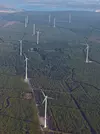Climate protection, CO2 sinks and energy generation.
Chransdorf wind farm in the forest
The "Chransdorf" project in Brandenburg comprises 24 Nordex N117/2400 wind turbines with a total height of 200 metres. The wind turbines generate an annual electricity volume of approx. 185,000 MWh, which corresponds to an average annual electricity demand of approx. 53,000 households. The wind farm was completed in September 2015.
In the course of drawing up the development plans for the municipality of Altdöbern and the town of Großräschen, a landscape conservation plan was drawn up. This greenspace expert report calculated the total compensation required for the Chransdorf wind farm to ensure nature conservation and determined its monetary equivalent.
Overall, compensation measures suitable for nature conservation had to be implemented to compensate for the loss of biotopes, soil functions and habitats as well as the impairment of the landscape in the order of approximately EUR 2 million.

Questions on wind energy in the forest
One third of the Earth's land is covered by forest. By expanding onshore wind energy, we can make a significant contribution to achieving the energy targets. Therefore, the use of suitable forest areas is important to achieve a 100 per cent renewable energy supply.
As in the open countryside, the planning and construction of wind turbines in the forest is subject to strict rules and regulations. Anyone who interferes with the forest ecosystem must have good reasons for doing so. One of these reasons is to protect the forest itself from negative influences and to make it more resilient to the impacts of climate change, such as through forest conversion measures. Forest wind energy is climate protection, a CO2 sink and second-level energy generation.
First things first: Especially valuable forest areas cannot be used for wind energy. These include, for example, deciduous and mixed forests as well as protected areas with a particularly high ecological value for humans and animals. Only commercial forests that are already managed primarily for the production of timber can be considered.
Forest: artificial planting of mostly identical trees with the same stage of development, economic use through logging
Woodland: natural planting with a characteristic forest climate, high species diversity as well as different tree species and development phases
Wind energy in forests is particularly sustainable if so-called 'calamity areas' are used that have been completely or largely cleared of trees due to storm events or pest infestations. Especially during the drought years 2018 to 2020, soils dried out to a depth of 1.80 metres in some regions, leaves were shed prematurely and the bark beetle spread en masse. Unfortunately, the number of these damaged areas has increased significantly in recent years.
Permanent land use can be reduced by employing a space-saving concept and ensuring favourable site characteristics, for example if access roads are already in place, which in commercial forests may have been built for forestry purposes before wind turbines were constructed. When determining the best locations for the systems, it is important to pay attention to where trees are ready to be cut down anyway.
Another advantage is the secure rental income for forestry enterprises and their ability to put potentially damaged or clear-cut areas to good use. By regularly compensating for built-up sites through replacement afforestation, forest conversion and upgrading of forest sites, it also becomes possible to promote the creation of climate-resistant forests.
Once a site has been selected taking into account the impact rule, the forestry commission determines the compensation measures that will be needed. As a rule, this includes the obligation to carry out replacement afforestation or to upgrade the quality of existing forests. Through the targeted selection of climate-resistant tree species that match the local conditions of the site, the compensation measures can contribute to making the forest site more resilient to the impacts of climate change.
Generally speaking, each erection of wind turbines must be compensated. As a rule, considerably more forest is actually afforested than was actually cleared for the erection of the wind turbines.
The bottom line: Sustainable forest protection is only really possible with appropriate measures against climate change. Wind energy in forests can make an enormously important contribution to this.